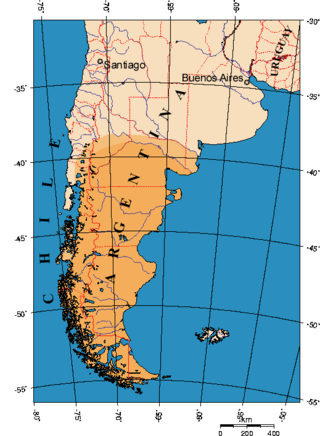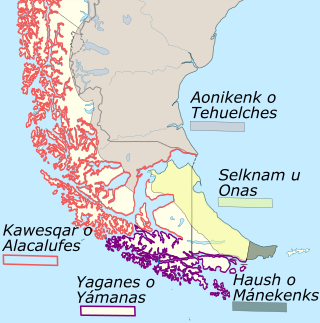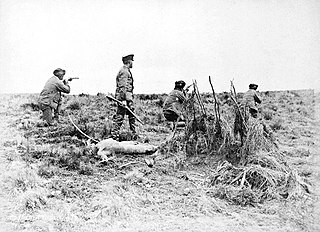
Patagonia is a geographical region that encompasses the southern end of South America, governed by Argentina and Chile. The region comprises the southern section of the Andes Mountains with lakes, fjords, temperate rainforests, and glaciers in the west and deserts, tablelands, and steppes to the east. Patagonia is bounded by the Pacific Ocean on the west, the Atlantic Ocean to the east, and many bodies of water that connect them, such as the Strait of Magellan, the Beagle Channel, and the Drake Passage to the south.

The Selk'nam, also known as the Onawo or Ona people, are an indigenous people in the Patagonian region of southern Argentina and Chile, including the Tierra del Fuego islands. They were one of the last native groups in South America to be encountered by migrant Europeans in the late 19th century. In the mid-19th century, there were about 4,000 Selk'nam; in 1916 Charles W. Furlong estimated there were about 800 Selk'nam living in Tierra del Fuego; with Walter Gardini stating that by 1919 there were 279, and by 1930 just over 100.

Julius Popper, known in Spanish as Julio Popper, was a Romanian-born Argentine colonial engineer, adventurer, and explorer. He was known as a modern "conquistador" of Tierra del Fuego in southern South America, and was both a controversial and influential figure. Popper was one of the main perpetrators of the genocide against the native Selk'nam people in the islands, and the circumstances surrounding his own death remain a mystery.

The Tehuelche people, also called the Aónikenk, are an Indigenous people from eastern Patagonia in South America. In the 18th and 19th centuries the Tehuelche were influenced by Mapuche people, and many adopted a horseriding lifestyle. Once a nomadic people, the lands of the Tehuelche were colonized in the 19th century by Argentina and Chile, gradually disrupting their traditional economies. The establishment of large sheep farming estates in Patagonia was particularly detrimental to the Tehuelche. Contact with outsiders also brought in infectious diseases ushering deadly epidemics among Tehuelche tribes. Most existing members of the group currently reside in cities and towns of Argentine Patagonia.
Ona, also known as Selk'nam (Shelknam), is a language spoken by the Selk'nam people in Isla Grande de Tierra del Fuego in southernmost South America.

Fuegians are the indigenous inhabitants of Tierra del Fuego, at the southern tip of South America. The name has been credited to Captain James Weddell, who supposedly created the term in 1822.

Spanish is the language that is predominantly understood and spoken as a first or second language by nearly all of the population of Argentina. According to the latest estimations, the population is currently greater than 45 million.

Spanish is the de facto official and administrative language of Chile. It is spoken by 99.3% of the population in the form of Chilean Spanish, as well as Andean Spanish. Spanish in Chile is also referred to as "castellano". Although an officially recognized Hispanic language does not exist at the governmental level, the Constitution itself, as well as all official documents, are written in this language.
Puelche was a language formerly spoken by the Puelche people in the Pampas region of Argentina. The language is also known as Gününa Küne, Gennaken (Guenaken), Northern Tehuelche, Gününa Yajich, Ranquelche, and Pampa.

Tehuelche was one of the Chonan languages of Patagonia. Its speakers were nomadic hunters who occupied territory in present-day Chile, north of Tierra del Fuego and south of the Mapuche people. It is also known as Aonikenk or Aonekko 'a'ien.
The Fuegian languages are the indigenous languages historically spoken in Tierra del Fuego by Native Americans. Adelaar lists the Fuegian languages as the Kawésqar language, the Ona language and the Yaghan language in addition to Chono, Gününa Yajich, and the Tehuelche language.
Mosetén–Chon is a proposal linking the Mosetenan languages and the Chonan languages of South America. Kaufman (1990) finds the connection fairly convincing.

The Haush or Manek'enk were an Indigenous people who lived on the Mitre Peninsula of the Isla Grande de Tierra del Fuego. They were related culturally and linguistically to the Selk'nam people who also lived on the Isla Grande de Tierra del Fuego, and to the Tehuelche people of southern mainland Patagonia.
The Teushen language is an indigenous language of Argentina, which may be extinct. It was spoken by the Teushen people, a nomadic hunter-gatherer people of Patagonia, who lived between the Puelche people to their north and the Tehuelche people to the south, who occupied the central part of the Tierra del Fuego region. The tribe is now extinct.

The Selk'nam genocide was the systematic extermination of the Selk'nam people, one of the four indigenous peoples of Tierra del Fuego archipelago, in the late 19th and early 20th centuries. Historians estimate that the genocide spanned a period of between ten and twenty years, and resulted in the decline of the Selk'nam population from approximately 4,000 people during the 1880s to a few hundred by the early 1900s.

The extinct Het languages are any of several putative languages, possibly related, that may have been spoken by the Het peoples.
The Haush language was an indigenous language spoken by the Haush people and was formerly spoken on the island of Tierra del Fuego. The Haush were considered the oldest inhabitants of Tierra del Fuego; they inhabited the far eastern tip of the Mitre Peninsula. They made regular hunting trips to Isla de los Estados.
The Teushen or Tehues were an Indigenous hunter-gatherer people of Patagonia in Argentina. They were considered "foot nomads", whose culture relied on hunting and gathering. Their territory was between the Tehuelche people to the south and the Puelche people to their north.

Ramón Lista was an Argentinian soldier and explorer. He was the second governor of the Territorio Nacional de Santa Cruz, precursor of Santa Cruz Province, Argentina. He played a key role in the Selk'nam genocide in Tierra del Fuego. Later he identified with the indigenous people of Patagonia, and went to live with them until he was recalled to Buenos Aires. Lista wrote a number of books on the people and places he had found.












